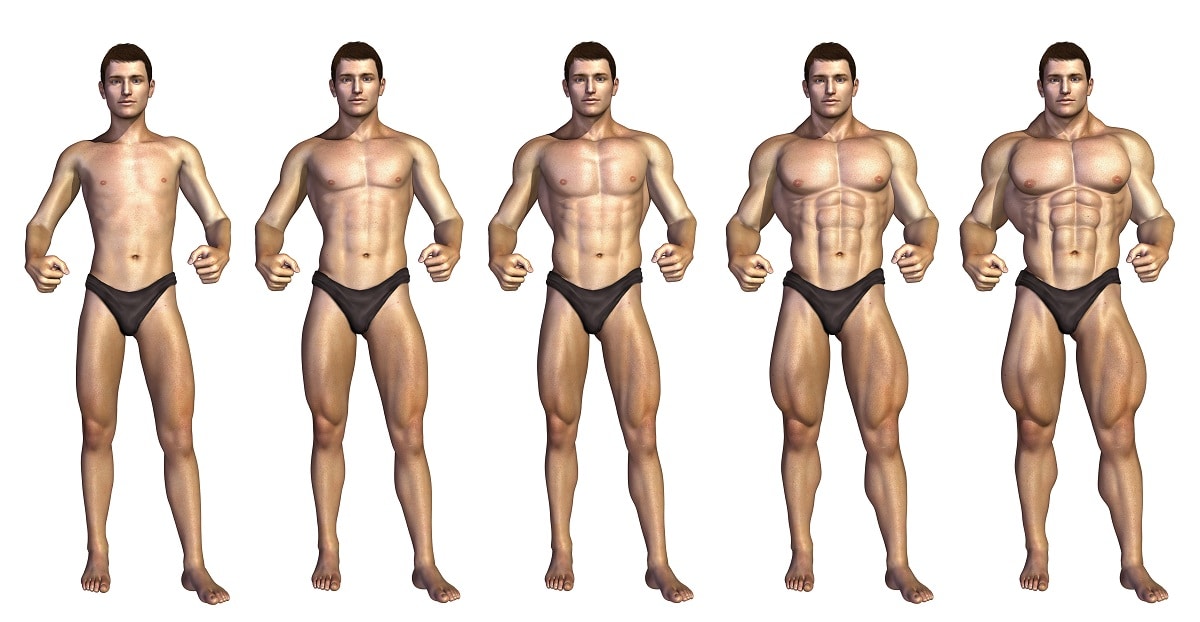
La hypertrophy It is something that most people who join the gym are looking for. It is nothing more than the gain of muscle mass as a result of the exercise of weights. Hypertrophy is something that occurs both at the muscular and cellular level. For this generation of new muscle tissue to be produced, it is necessary to have a stimulus and a diet according to the objective.
In this article we are going to tell you everything you need to know about hypertrophy and what are the best tips for it.
What is hypertrophy

Muscle hypertrophy is an increase in the size of a muscle or its cross-sectional area attributed to an increase in the size or number of myofibrils. These myofibrils are composed of actin and myosin. They are found within a given muscle fiber. It can occur in both type I and type II muscle fibers. It occurs to a greater extent in the second type.
It must be borne in mind that for an increase in muscle tissue to occur, an energy surplus is necessary. This energy surplus is achieved with a higher calorie intake than is spent on a daily basis. This is known by the name of caloric surplus. The calories we eat on a daily basis support a person's nutrition. By our daily physical activity, at our height, age, weight, etc. We have a caloric expenditure that we must cover. If this caloric expenditure is offset by a higher calorie intake in a sustained way over time, we will achieve the ideal conditions for an increase in muscle mass.
You have to understand that the body does not understand what type of exercise we are doing, but stimuli. Not only do we need a sustained energy surplus over time, but we also need to give the muscle sufficient stimulus to generate hypertrophy.
Hypertrophy benefits

There is a strong correlation between muscle cross-sectional area and muscle strength. This means that the more muscle mass we have, the greater potential is created to be able to develop more strength. By having a greater Strength, training and muscle mass have a positive effect on body composition. In this way, we address two of the three factors that comprise energy expenditure. This energy expenditure is due to the following points: resting metabolic rate, physical activity and thermic effect of food.
By constantly entering the force we are causing an increase in energy expenditure not only during exercise, but in the hours after the activity. In addition, the amount other than the fat-free amount represents approximately 70% of an individual's resting metabolic rate. Therefore, by having an increase in muscle mass we have as a result an increase in the basal metabolic rate at rest. That is, a person with a greater amount of muscle mass will need to eat more calories in order to maintain these muscles and their body weight.
Body composition is measured as a percentage free of fat versus fat mass. The body fat percentage of an individual can be decreased if hypertrophy is worked very well.
Working the muscles

The three main factors that generate hypertrophy in the body are the following: mechanical stress, muscle damage and metabolic stress. The degree of mechanical stress in a strength training session is determined by the intensity and time under stress. When we talk about intensity we refer to the amount of load we are lifting in the exercises. The time under tension is the duration of the applied load. The greater both are, the greater amount of hypertrophy occurs. However, the degree of fatigue must be taken into account. We must choose the exercises and the necessary load to optimize the stimulus and fatigue radius.
Strength training creates an overload situation causing some muscle damage and an inflammatory response. This enhances the release of various growth factors. On the other hand, metabolic stresses are the foot of the training program that is highly dependent on the anaerobic system. This is how the pH level is lowered and the breakdown of muscle fibers is caused.
There are several ways to induce hypertrophy by doing exercises. Multiple series with moderate loads can be used in a rep range of 6-12 with a percentage of 65-85% 1RM. The 1RM is the massive repetition that we can perform with a certain load. That is, the maximum weight we can lift in one repetition. Metabolic stress can also be stimulated with rest periods of approximately 60 seconds creating a further increase in growth hormone testosterone. These two hormones belong to the group of primary anabolic hormones.
On the other hand, if we analyze heavy loads in a repetition range of 1-5 with a 1RM percentage greater than 85% and with longer breaks of 2-5 minutes, hypertrophy can also be performed. On the other hand, if we work at an RM of less than 65% and with more than 12 repetitions with short rest periods of approximately 30 seconds, we can also generate hypertrophy.
Lastly, muscle tension, damage, and metabolic stress cause some anabolic response that stimulates recovery to return the body to homeostasis. After homeostasis supercompensation occurs. It refers to increasing the body's ability to handle the stress of training. In a simple way, the body is able to repair all its tissues above the previous capacity so that the same training does not cause the same amount of damage. In this way, positive adaptations are continually caused.
Training schedule
Training scheduling must take into account all training variables. That is, you must progress systematically by modifying the training variables that are frequency, volume, intensity, rest periods, and exercise selection. ANDl training volume in the most commonly adjusted variable.
I hope that with this information you can learn more about hypertrophy and how it takes place.